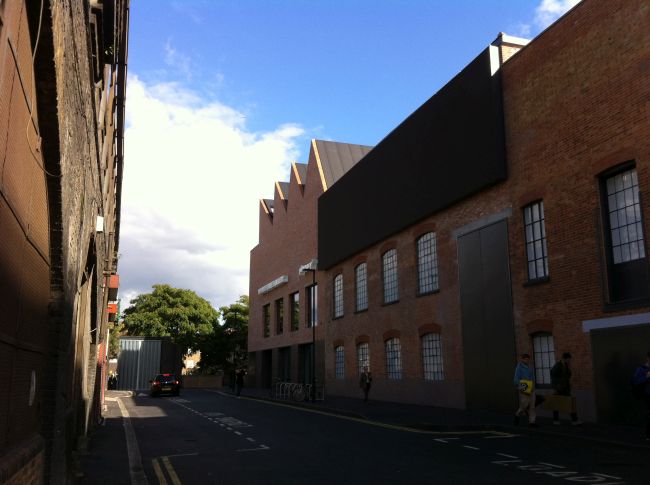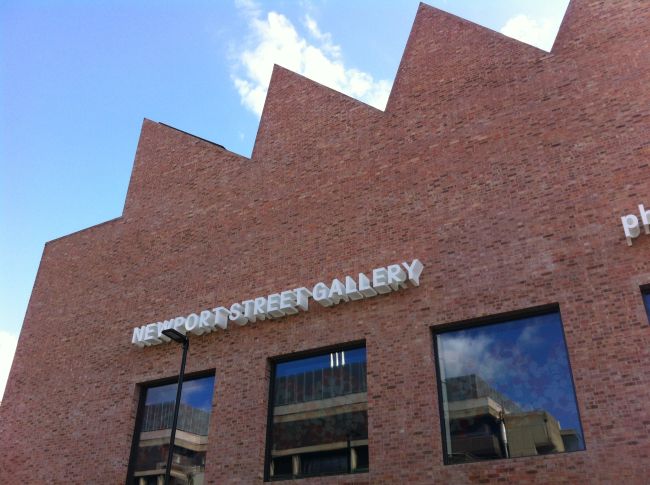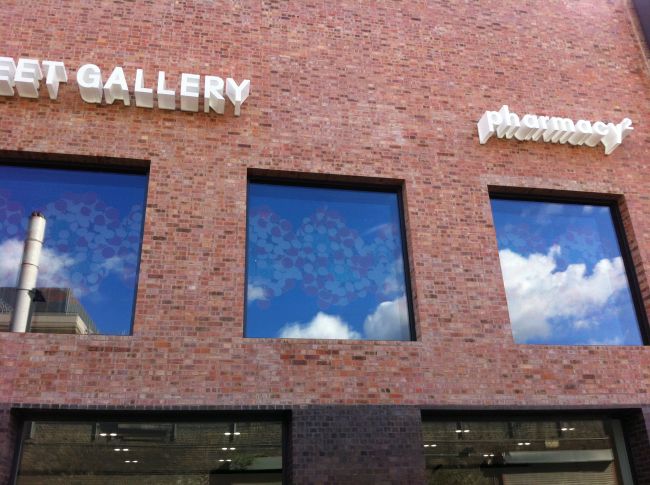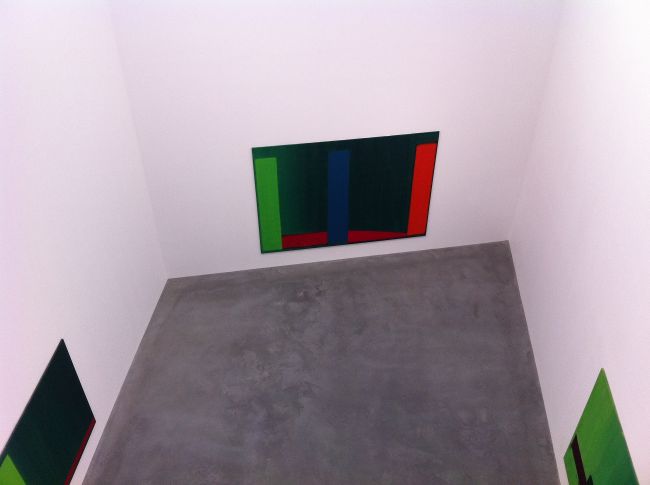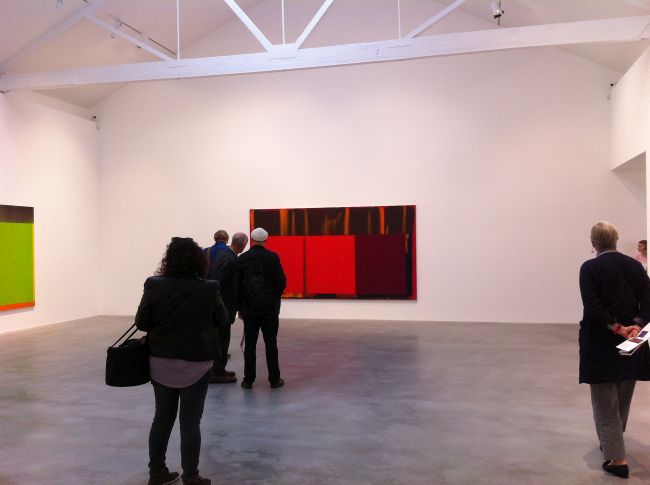
Officially Uncool
21/10/2015
An acquaintance of mine, an American artist who spent a year and a half in London, recently told me an important snippet of news: in progressive art circles Damien Hirst is now officially pronounced as uncool. I sighed with relief because I wanted to finish thinking all I thought about Hirst for a long time now, but, although weakening, nevertheless his coolness prevented me from doing so. Of course the strong pull exists to tease, to make ironic comments, to discredit the authoritative opinion, as it usually happens with officially recognized coolness, and these things only get in the way. It is necessary to understand, and understanding comes in the silence and even oblivion of the said object. Basically, really relieved and in excellent spirits, I went to Newport Street, where the Newport Street Gallery recently opened on the premises owned by Damien Hirst, reconstructed using Damien Hirst’s money, and which from now on will be exhibiting art (but not Damien Hirst’s art) and other pieces from Damien Hirst’s collection. The explanation given (officially!) for this is that Damien Hirst is consumed with guilt over the fact that everything collected by him since childhood (several thousand objects!) are gathering dust in drawers, closets and other storage areas far away from the eyes of an enlightened public, so he made his collection available. Suffice to say it is worthwhile to drop in on Newport Street.
As I was walking to the gallery I ran into the real Damien Hirst. He was in a hurry to a restaurant on Newport Street, and as it is now the norm, the restaurant was opened in a former workshop. Hirst looked as if he humbly accepted the official verdict of the art crowd: he looked uncool. Nothing in particular was the matter with him, he looked just like his photographs, with heavy glasses, short gray hair, an undistinguished English face, but his habits revealed the uncoolness. Damien Hirst lost the look of the chic psychotic debt collector of art from the past, he became ... well, ordinary, or something like that. Just a man wearing indistinguishable black-casual which the usual exhibition visitors are usually clad in. The types that wander through the halls with either an arrogant expression or a bored one. They get animated only at the sight of someone familiar, they never usually see everything until the end and, having collected a handful of companions and drinking buddies, go to the nearest restaurant or wine bar. Yes, not a pub and not even a normal bar with a zinc counter, as did Francis Bacon and Lucien Freud, but to places which appeared in London during the Thatcher neoliberal revolution. Later, during the days of Cool Britannia, in the era of Tony Blair’s “New Labour” (the best national anthem of which was Pulp’s song “Cocaine Socialism” which goes like this: “Do you want a line of this? / Are you a (sniff) / socialist?”), wine bars and expensive Italian restaurants were flourishing at the foot of the City’s financial peaks. In the evenings traders, investors and other crazed-from-cocaine-expectations public descended from the top to the wine flowing freely underneath with the cheerful banter about chicks and the like. Yes, the artists of Hirst’s social aura preferred to mix with the crowd of the rich, the brazenly rich. No bohemian lifestyle, only celebrities and the latest moneybags. And it was cool. And Britainnia was cool. And everything was cool. Then the nineties ended, the noughties became quite pale imitations of the nineties, the inertia somehow lasted five more years, and now comes the official announcement: uncool. Actually, in all of Hirst’s art, in addition to his genius sense for the bleak beauty, I was interested only in the socio-cultural and socio-economic mechanism of the “cool” state of being. Now, in retrospect, we can, without any noise, quietly think about it. The Newport Street Gallery was a perfect place for this.
Photo:
Newport Street is parallel to the railway viaduct which stretches along the south bank of the Thames, between Vauxhall and Waterloo train station. The northern part of the Lambeth district is one of the most uninteresting places in the city. Southern Lambeth is already very different, because Brixton is situated there, where the song “Guns of Brixton” takes place, and now still offers plenty for the eyes to see and imagination to experience. Northern Lambeth is only known for the rather modest Lambeth Palace (the residence of the Archbishop of Canterbury), a few bleak office buildings mainly from the 1980-90s, and also even more bleak social housing estates. The landscape gets only slightly perked up by the remains of the industrial epoch, such as the small factories, warehouses, workshops and the railway viaduct which I had already mentioned. Everything is painted that red-pink brick color. The same color and materials can be seen on the buildings of the little Newport Street, which is situated in the back alleys, and of course you will not find anything but neglect on it. Although to be more correct, you COULD NOT find anything but neglect. A few years back on the southern bank of the Thames developers took matters into their own hands, preceded, as per usual, by progressive artists and designers. However, although the Peckham area truly became more fun while retaining the picturesqueness of the drab neighborhood, now diluted by galleries, cafes and places to host vague literary and art events, northern Lambeth had a different story. Here everything is dead, but not like the aftermath of a great battle with blood, abandoned guns on broken masts aiming at the sky, wheezing wounded soldiers, horses struggling in agony. Here everything is dead in another way, in a post-modernist, post-industrial and neo-liberal way. Such drab lifelessness could only be created by the parasitic “creative industry” which infests the ruins of the present industry. For example, a similar lifelessness is nowadays ruling the center of Manchester, which used to be dirty, cruel, fun, where there was Hacienda (night club) and similar endeavors, but now there are plenty of places for the “bobo”[1], but to be the “bobo” one needs money, and for money our “bobo” must go to work. Therefore party-time only happens on the weekend. During the weekday the gentrified center of Manchester is a cemetery of the gravediggers’ good intentions from classic industrialism. Northern Lambeth and Newport Street is somewhat similar, but only even more lifeless. Simply put, the temperament of the people in Manchester is different, and the scale of the industrial ruins is more grand there. The post-new is nesting in already finished walls on Newport Street, not necessarily aiming for the sky. Hirst was hurrying to be in this exact breeding ground, the red-brick courtyard workshop, just below the viaduct, so that from the bottom can even capture the gaze of the passengers’ faces who are rushing to London from the suburbs, and as for the top... well, there is almost nothing to look at. The yard was glazed, the lieutenants of “creative industries” sat there eating pasta and drinking red wine and skinny anguish lay surrounding them. A well-known brawler, now pronounced uncool, hastened down the empty street, and I hurried in the opposite direction to where our hero came from, to the gallery made on his money in order to get rid of the guilt he felt in front of the respectable audience. Cool.
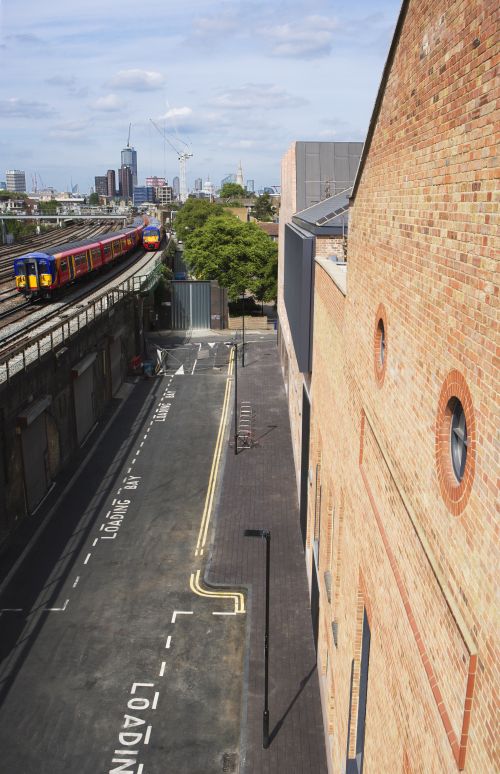
NPSG facade and tracks © Kioyar Ltd, Photo Yuki Shima
This construction is a few old buildings joint together by the architects from the modern firm Caruso St John. There are two kinds of storage spaces in the middle, but with triangles at the top of the facade sticking out which hid the glass roof. On each side there are two old houses of the same red-pink brick as everything around. Now it is a complex. The former warehouses and the buildings on the left are, in fact, the gallery and the gallery’s office, the shop and so on. The house on the right went on to become a restaurant, which will open next year.
Photo:
Really though, what could be more logical than to put a restaurant here, in the gallery, right next to the gentrified workshops, under the trains carrying London’s working public to offices in the mornings and home in the evenings? They have their own life, clumsy and somewhat difficult, while here we have the perfect cleanliness of lines, white walls, humongous emptiness and the surgical tidiness of the operating room. It is said that the restaurant will be thematic, dedicated to Hirst’s one of his two main obsessions: medicine. By the wall there will be glass cabinets with surgical instruments arranged ideally, everything will shine with chrome and make the visitors recall the terror of the unfortunate patient who is getting an anesthesia shot from the nurse before their surgery. Only in the nightmare of life do you get cut up. But here, at the restaurant, you deftly cut up steak and grilled fish. Claret and Bardolino replace the blood.
A few people stood at the entrance to the gallery, looking like art critics and taking photos of the facade with their iPhones. I pulled out my iPhone and started to do the same. We looked at each other with a knowing smile. Our facial expressions were business-like and exaggerated; I think everyone’s thoughts were headed in the same direction: how the devil can I find something to latch on? On the thought? The image? The metaphor? Nothing came to mind. The perfectly smooth, empty and dreary pink façade resembled the post-war social housing estate in my beloved Hackney, not the nine storey buildings but the lower houses. I am sure that Hirst knew about it; moreover, it seems he deliberately asked the architects to correlate the new design with the most ordinary, tautological, or something similar, from the city.
Photo:
Here is the logic behind it: here is London, here are its housing estates, and here is Hirst. He has a lot of money and a sudden feeling of guilt. He spends money to restore justice by giving the public the opportunity to see his collection, bought by the money Hirst earned from selling his works. To make his works, for example the diamond encrusted skulls and so on, Hirst spent money, which he earned by selling his previous works, which, in turn, he also spent money on. Money was born of money through the art-production, everything was cyclical, the same way London’s economy rotates based on the circulation of money in the City. Bankers make money out of money. Hirst was also making money out of money until the feeling of guilt started eating him up. And so he invites everyone to look at his money, embodied in another’s artifacts, exhibited in his reconstructed (by an expensive architect firm) buildings, which he asked to be remade in such a way as to reflect the image of the places where the viewer actually resides. This construction is rather sophisticated. I always admired Damien Hirst’s mind.
The surrounding art critics were not admiring anything, they were bored. They took on a serious look. They chose different angles for their iPhones, but then, already inside the gallery, they were suddenly filled with enthusiasm and took pictures of anything and everything. Although later they got bored, and even in the middle of the exposition I already didn’t meet any of them. On the other hand, in some way they were right, because further into the exposition everything was more or less the same. Same idealistically white halls of different geometric shapes covered in large abstract canvases. A few spiral staircases leading to the second floor. There it was pretty much the same.
Photo:
In some way the genius is in repetition and boredom, especially the boredom organized specifically, because here, like in IKEA, you walk around in a circle. At one point I decided to check, what would happen if I walked to the end of the enfilade of the first floor, went upstairs, walked to the end there and went back down? What if there would be something different? In a weird way I found myself not at the beginning of the exposition of the first floor, but at its very end. Like Borges’ “Library of Babel”, only without book shelves.
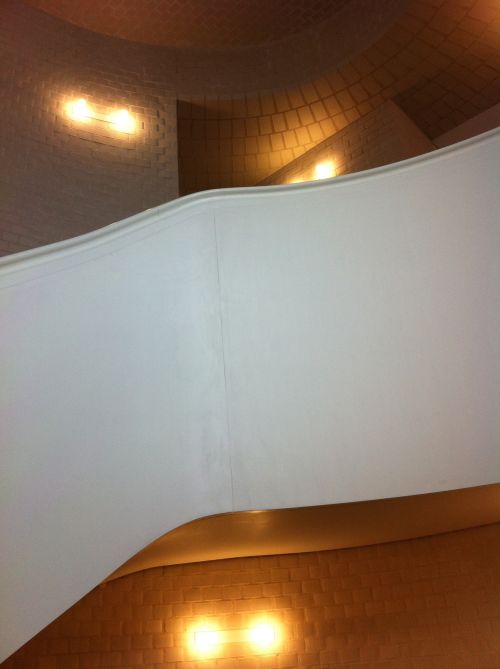
Photo:
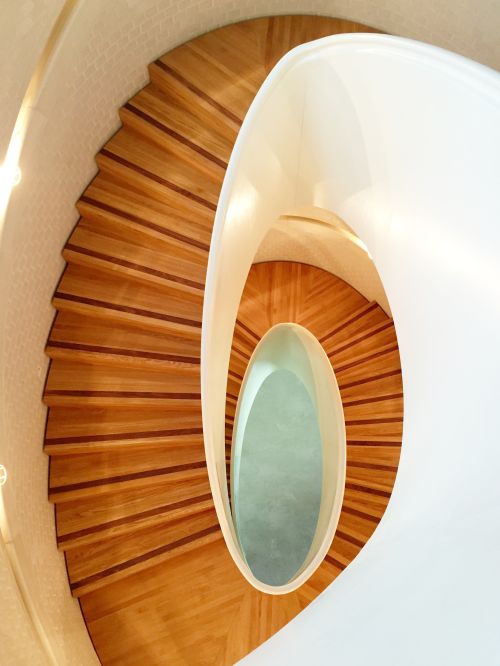
NPSG stairwell © Kioyar Ltd
There weren’t many visitors, the art crowd was easily identifiable by the clothes, the purposely indifferent look, the tenacious surreptitious gaze, attention to the seemingly invisible (in the opinion of a simpleton) details. Actually, Hirst belongs to this crowd. I would bet a small fortune that those who came out of the Newport Street Gallery went to the restaurant in the former workshop to drink a glass of something, eat a salad or poke a plate of carpaccio with a fork. Then they called a taxi and got home to their small apartment in Shoreditch or Dalston, and in the evening went to sit in another place or stand with a glass in hand in the field of socially similar socialization. I wandered through the halls trying to think of some other story lines, in addition to the one imposed on me here by Hirst and the employees of Caruso St John. The dyed yellow-pink hair of a female gallery attendant seemed quite funny rhymed with the palette of the image hanging in the hall where she worked. That's pretty much it.
Photo:
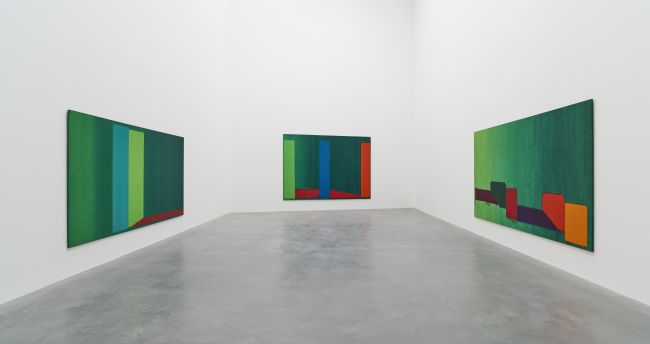
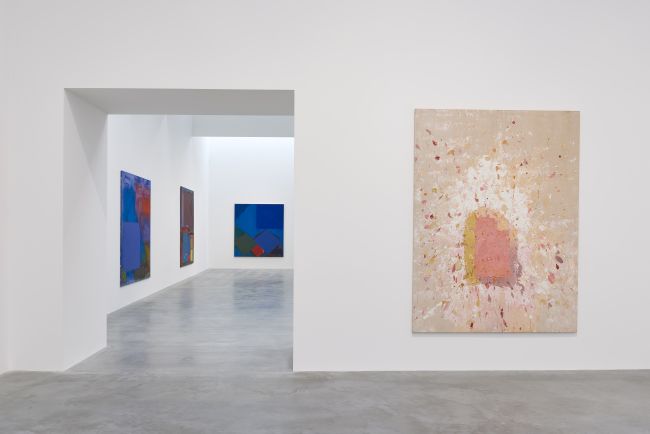
© Kioyar Ltd, Photo by Prudence Cuming Associates
As always, history helped me out here. It brought the ideally constructed lifelessness of Hirst’s gallery back into life by burdening it with a curious social meaning. First of all, if we look back a hundred years, those were not workshops but artist’s studios. So first of all they were warehouses and then those buildings were given to theater artists, because the West End was going through a revival, theaters grew like mushrooms, the shows needed to be decorated, so here decorations were painted in an almost conveyor-like way. Therefore craft was being created here, in some way a people’s art. Hirst bought those workshops 30 years ago, created his studio here, but as it is well-known that he doesn’t make his artworks himself, therefore this was a sort of art factory. Of course it is tempting to imagine yourself as Damien Hirst, who, having rolled back his sleeves, is sawing a calf in half with a power-saw, or pouring formaldehyde into a gigantic glass aquarium where an already dead shark is lying, but oh well. The place which used to house decorations for popular spectacles now housed the creations of millionaire escapist necrophilic art. Then this got old too. And here, I think, is when Damien Hirst suddenly got a genius idea. The place where the corpses of animals were covered in formaldehyde, where in glass cabinets dead butterflies were hung carefully, now was made into a gigantic dead butterfly of contemporary art. All in all Newport Street Gallery is a perfectly prepared and preserved dead life of the recently still alive art. In the end, they are exhibiting the “collection” or the “cabinet of curiosities” of the great collector of all kinds of dried up stuff.
Here we are leaving history and moving towards a somewhat questionable historiosophy. The Young British Artists, which Hirst belongs to, was the spawn of the late Thatcher era, same as modern-day Britain. The neo-liberal revolution of 1980-1990's, under whatever slogans it may pass, the Tories or Blair’s “New Labour”, very radically changed the country. The idea was to make another America out of Britain, opening the floodgates to unlimited individualism, abandoning the old social values of the stratified society, blurring the caste walls by the cash flow. “The invisible hand of the market” was to turn a provincial, gray and obsolete ex-great power into something new, attractive, interesting, and finally cool. Make it cool. At some point in the second half of the 1990s it seemed to have succeeded; the country suddenly found itself (and others found it like that also) in the image of greedy pleasure-seeking, brash, talented and self-confident “Young British Artists”, the stars of “Britpop”, and a new generation of small but compelling actors like Stephen Fry. In some ways it is a very strange strain of socialism, as everyone who could and who wanted to “give according to his abilities”, “received according to his needs”. The main thing was to want. Then it all went away, the financial bubble would burst from time to time, Oasis dried up and collapsed, Tracey Emin stopped publicly displaying her dirty bed implanted with various intimacies, preferring to do mediocre scribblings. Tony Blair pulled the kingdom into the Iraq war by means of a hoax, and Cool Britannia was left only in dictionaries and on t-shirts in souvenir shops.
The veil fell off and the traits of the country shone through suddenly, the country which became even less adapted to normal life of an average person than in 1979 when Thatcher won the elections. All this time Damien Hirst continued to make very big money on simply bigger money and heroically ignored everything around him. He ended up being the most stoic soldier of the Thatcher era, always shrouded in scandals, diabolically inventive, an incredibly prudent creator of capitalist necrophilia. But even he got bored in the end. But Hirst wouldn’t be such a big artist if he wasn’t able to turn that boredom into a first-class art object. Technically, the Newport Street Gallery is the same type of monument to a particular historical period as the country’s prime minister David Cameron, who pretends like it is still 1983. Both the gallery and the prime minister are flat, empty and meaningless. Sometimes it seems to me that the current government of the UK invented Damien Hirst, mostly because, as Hirst, it has nothing to do with the lives of its people, or with life in general.
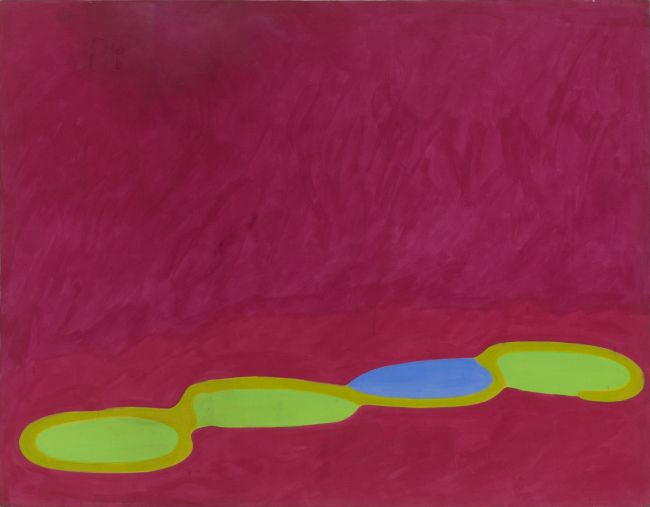
John Hoyland. 17.5.64 © The John Hoyland Estate, Photo Prudence Cuming Associates
I am sure the reader has noticed that I am avoiding talking about the paintings hanging in the Newport Street Gallery. In reality, it is a collection of abstract works by a good artist John Hoyland and all the works are dated between 1964 and 1982. They were created in a completely different context, socio-culturally, politically, and any other. Abstract artists were not very appreciated in Britain at the time, especially in the beginning of 1960s. The heroic period of American abstract-expressionism was only met with enthusiasm by very few. The leftist art figures fought against Jasper Johns and his company, seeing only the agents of cultural imperialism in them. Partially the Marxist critic John Berger insisted on this incredibly fruitful idea. All in all John Hoyland made his paintings during the times when British banks and other financial institutions were not dashing to decorate their walls with non-figurative paintings. Damien Hirst took those works from a live history, carefully stored them in collector’s cabinets, covered them slightly with talcum powder and naphthalene, and now hung them on the white walls of his gallery to show how much nothing makes any sense. Only ideal surface geometries exist with empty rooms, spiral staircases with steps made of special bog wood and whitewashed brick walls, as if sprinkled with cocaine. There is only the finality of form, order and the boredom of death, which was issued a certificate authorizing its exposure to the public by the sanitary epidemiological services. And as for the upcoming restaurant, it will feature scalpels and clamps in glass cabinets to somehow cheer up the fans of Italian cuisine.
Uncool is the new cool. Damien Hirst still remains the main artist of our time.
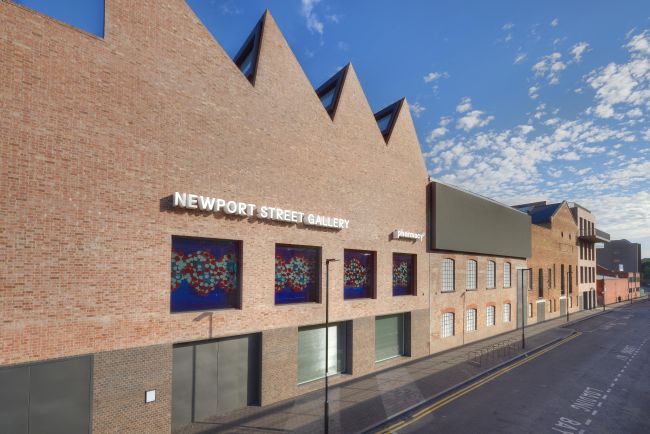
NPSG facade © Kioyar Ltd, Photo Prudence Cuming
[1] Translator’s note: abbreviated form of the words ‘bourgeois’ and ‘bohemian’, used to describe the 1990s successors of the yuppies.
